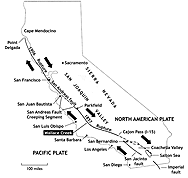|
What is a fault?
A fault is a fracture in the Earth's crust whose sides have moved in relation to each other.
What is the San Andreas fault?
 The San Andreas fault is a lateral fault. Lateral movement occurs when rock on one side of the fault slides horizontally past rock on the other side, with very little vertical motion. The San Andreas is a right-lateral fault. Geologists use the term right-lateral to describe the direction the fault moves. If you were standing on one side of a right-lateral fault and facing the fault, a person standing on the opposite side would move to your right during an earthquake. The San Andreas fault is a lateral fault. Lateral movement occurs when rock on one side of the fault slides horizontally past rock on the other side, with very little vertical motion. The San Andreas is a right-lateral fault. Geologists use the term right-lateral to describe the direction the fault moves. If you were standing on one side of a right-lateral fault and facing the fault, a person standing on the opposite side would move to your right during an earthquake.
 The San Andreas fault is also the boundary between the Pacific and North American tectonic plates. The fault is about 700 miles (1100 km) long, stretching from Cape Mendocino to the Salton Sea. On average, the Pacific side is moving horizontally past the North American side at a rate of 1.3 inches (34 mm) per year -- about as fast as a fingernail grows. But the fault here is not moving every single minute -- it only moves during large earthquakes, which happen once every few hundred years. At Wallace Creek, it moved 30 feet (9 m) on January 9, 1857. The San Andreas fault is also the boundary between the Pacific and North American tectonic plates. The fault is about 700 miles (1100 km) long, stretching from Cape Mendocino to the Salton Sea. On average, the Pacific side is moving horizontally past the North American side at a rate of 1.3 inches (34 mm) per year -- about as fast as a fingernail grows. But the fault here is not moving every single minute -- it only moves during large earthquakes, which happen once every few hundred years. At Wallace Creek, it moved 30 feet (9 m) on January 9, 1857.
|


 Download
a PDF Copy!
Download
a PDF Copy!
 Directions
to Wallace Creek
Directions
to Wallace Creek The
San Andreas
The
San Andreas
 Along
the Trail
Along
the Trail
 Science
in Action
Science
in Action GSA
Wallace Creek Guide
GSA
Wallace Creek Guide
 Carrizo
Plain Geologic Tour
Carrizo
Plain Geologic Tour Technical
Paper
Technical
Paper Wallace
Creek Exercises
Wallace
Creek Exercises
 SCEC
Education Module
SCEC
Education Module The
Last Big One
The
Last Big One
 Earthquake
FAQs
Earthquake
FAQs
 Earthquake
Definitions
Earthquake
Definitions
 Related
Links
Related
Links
 Further
Reading
Further
Reading
 Are
You Prepared?
Are
You Prepared?